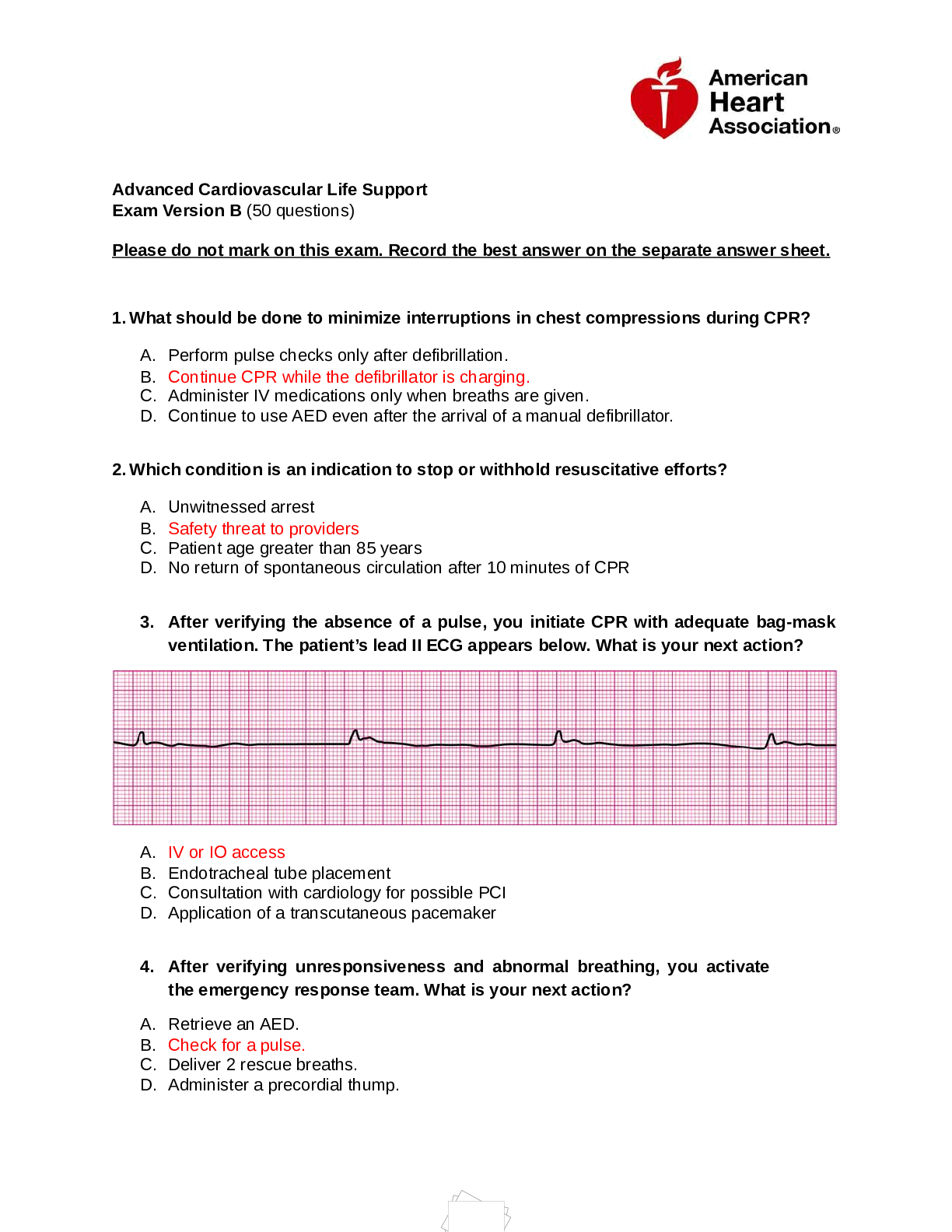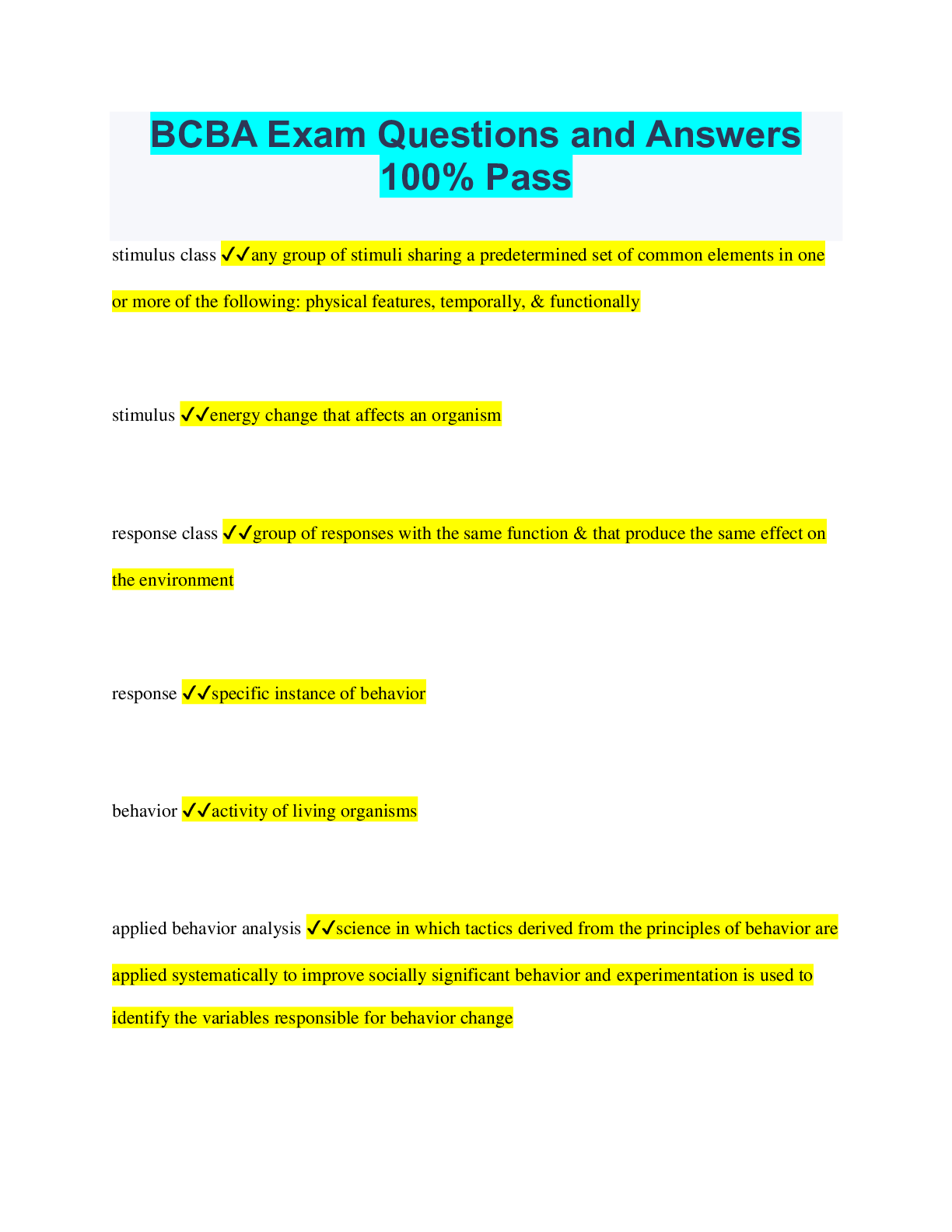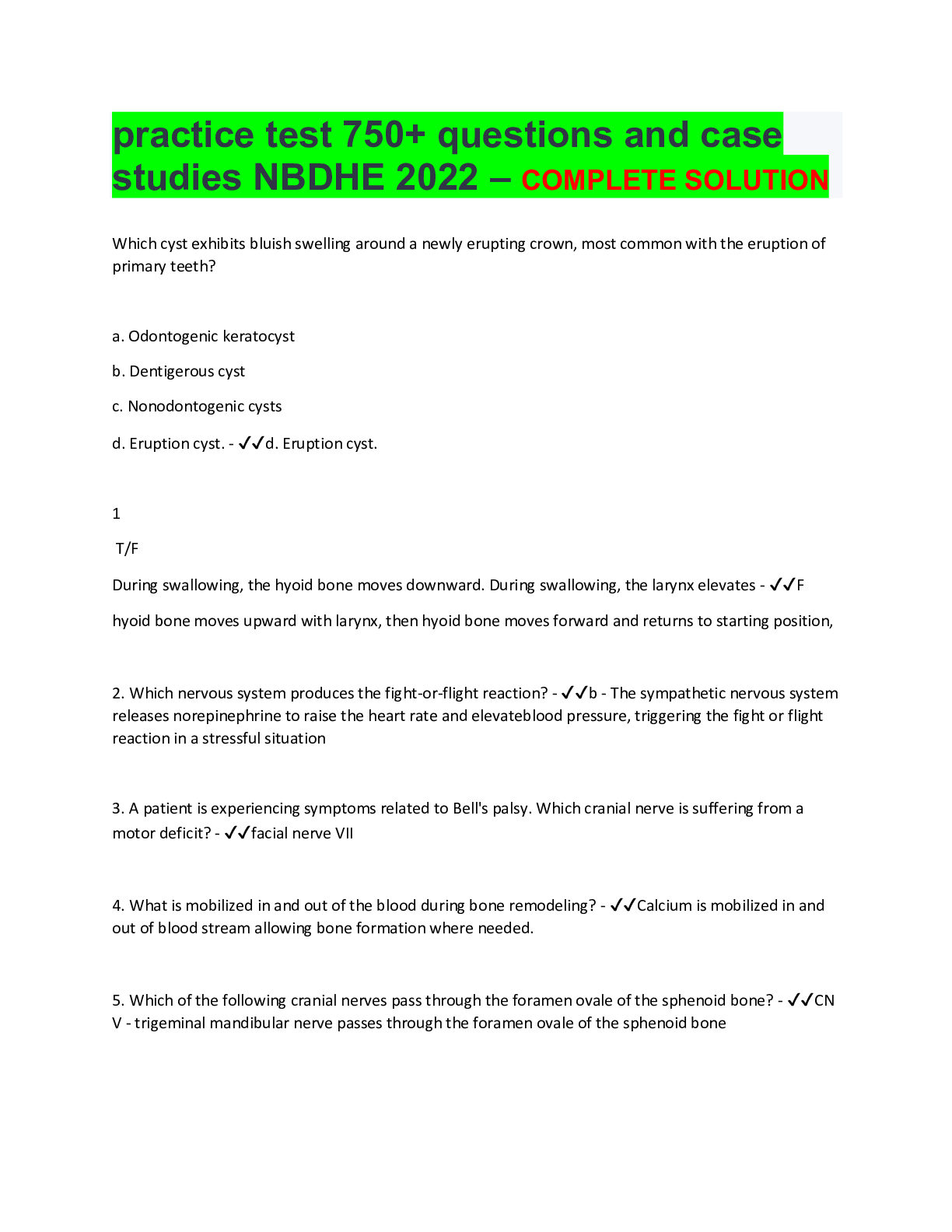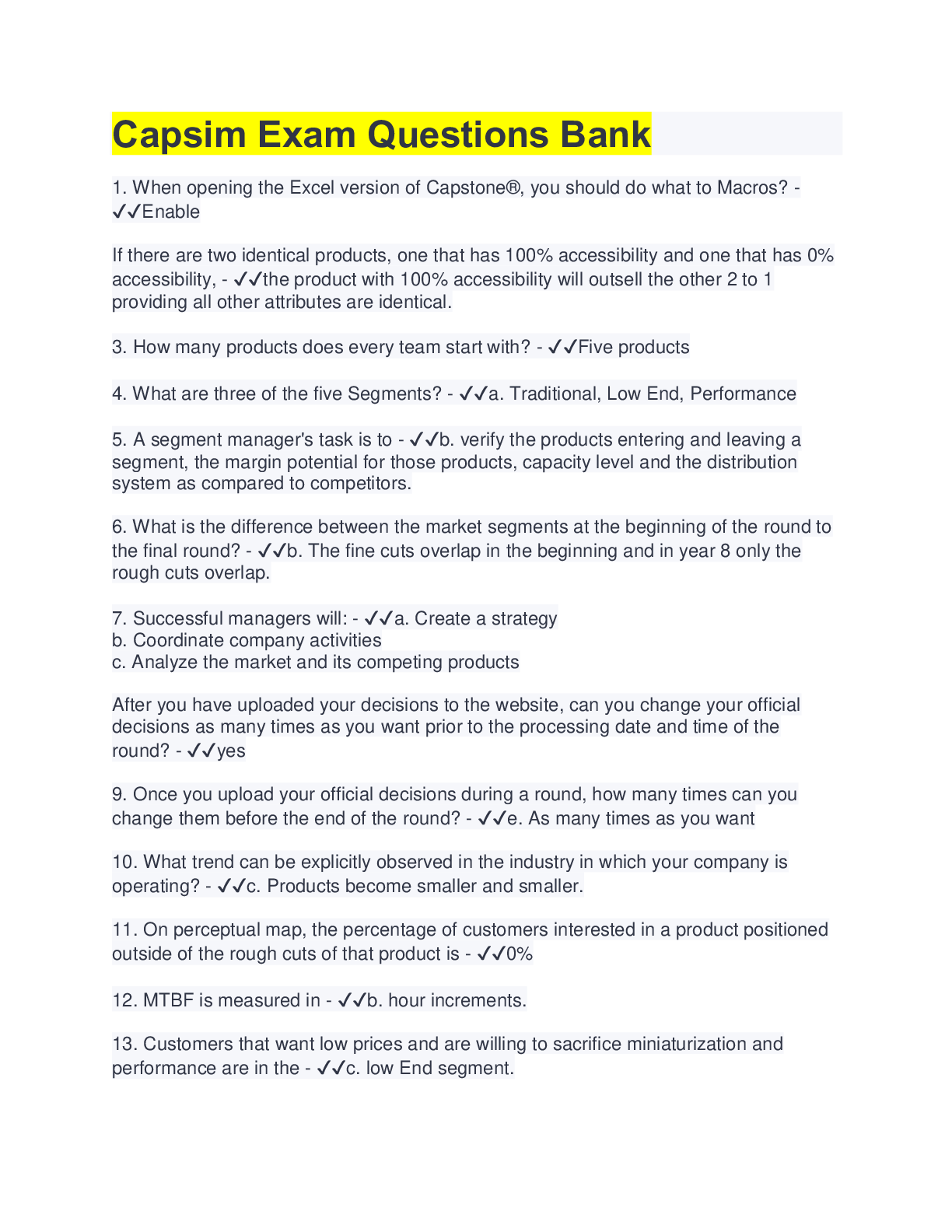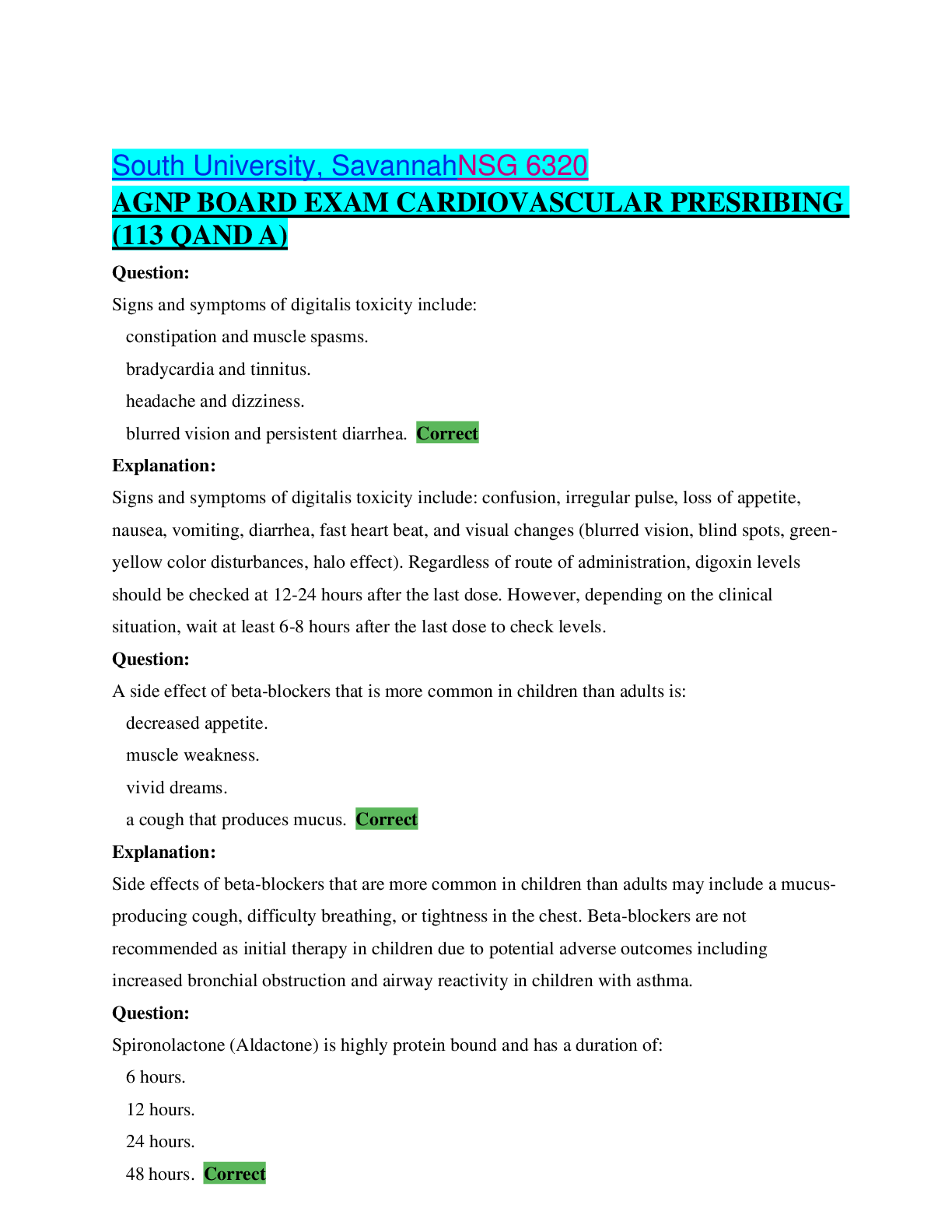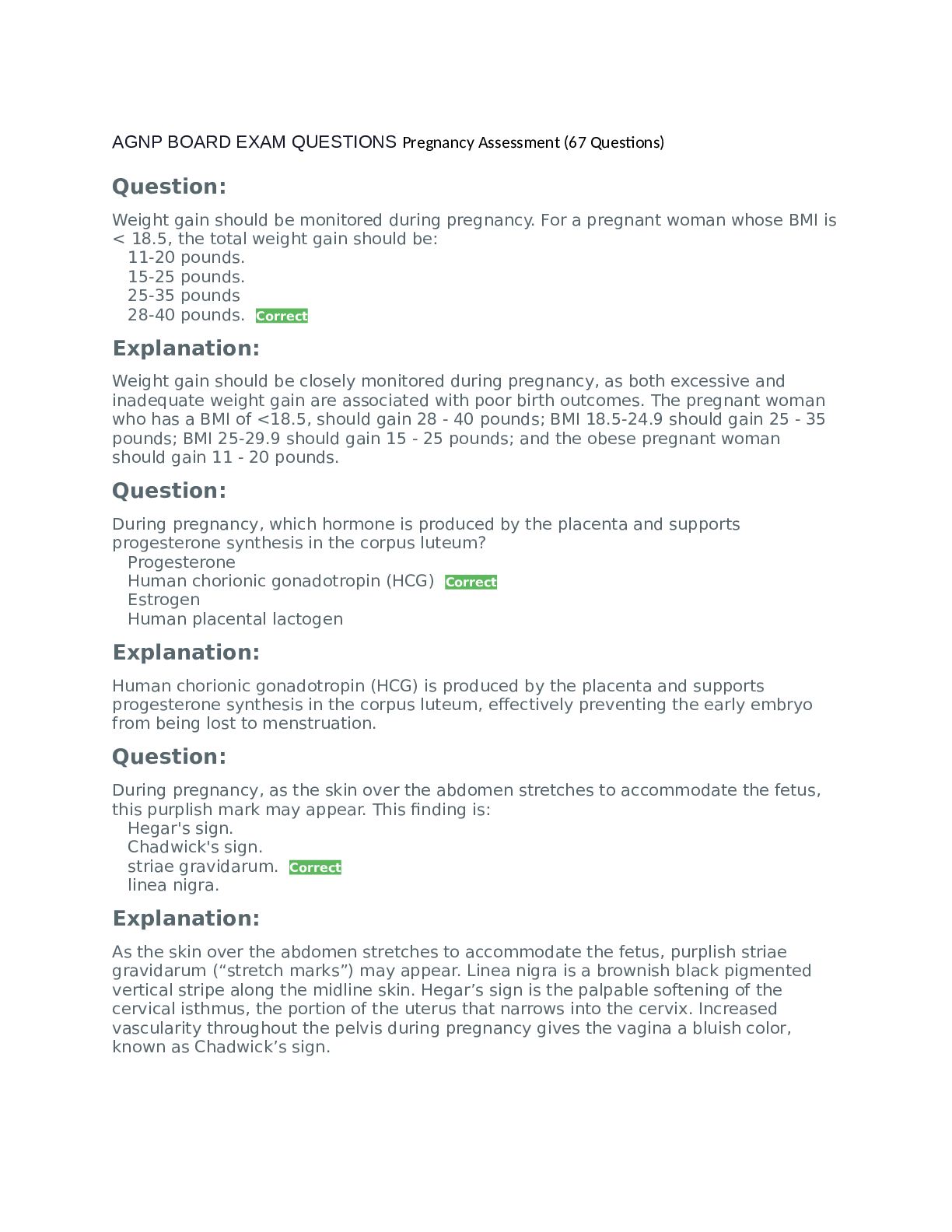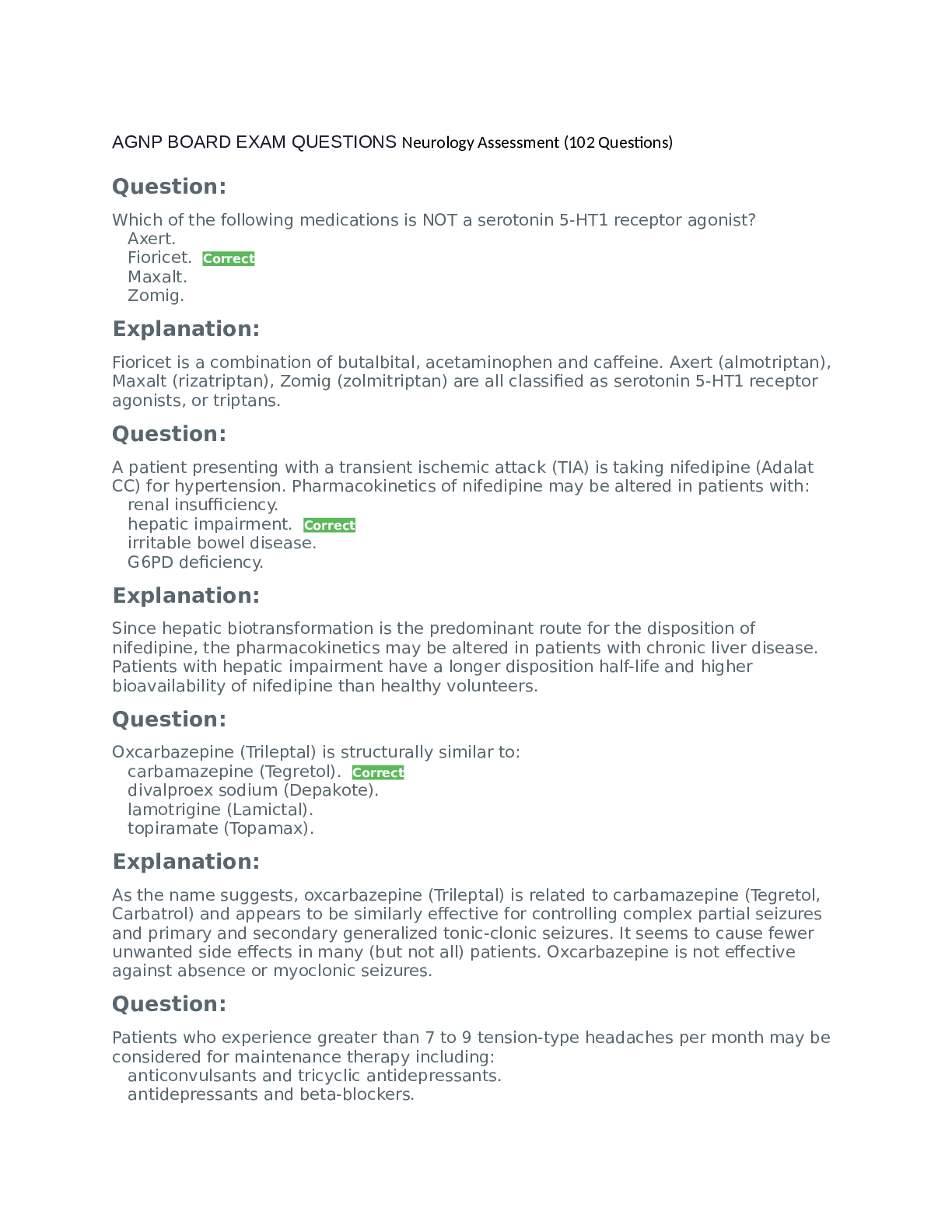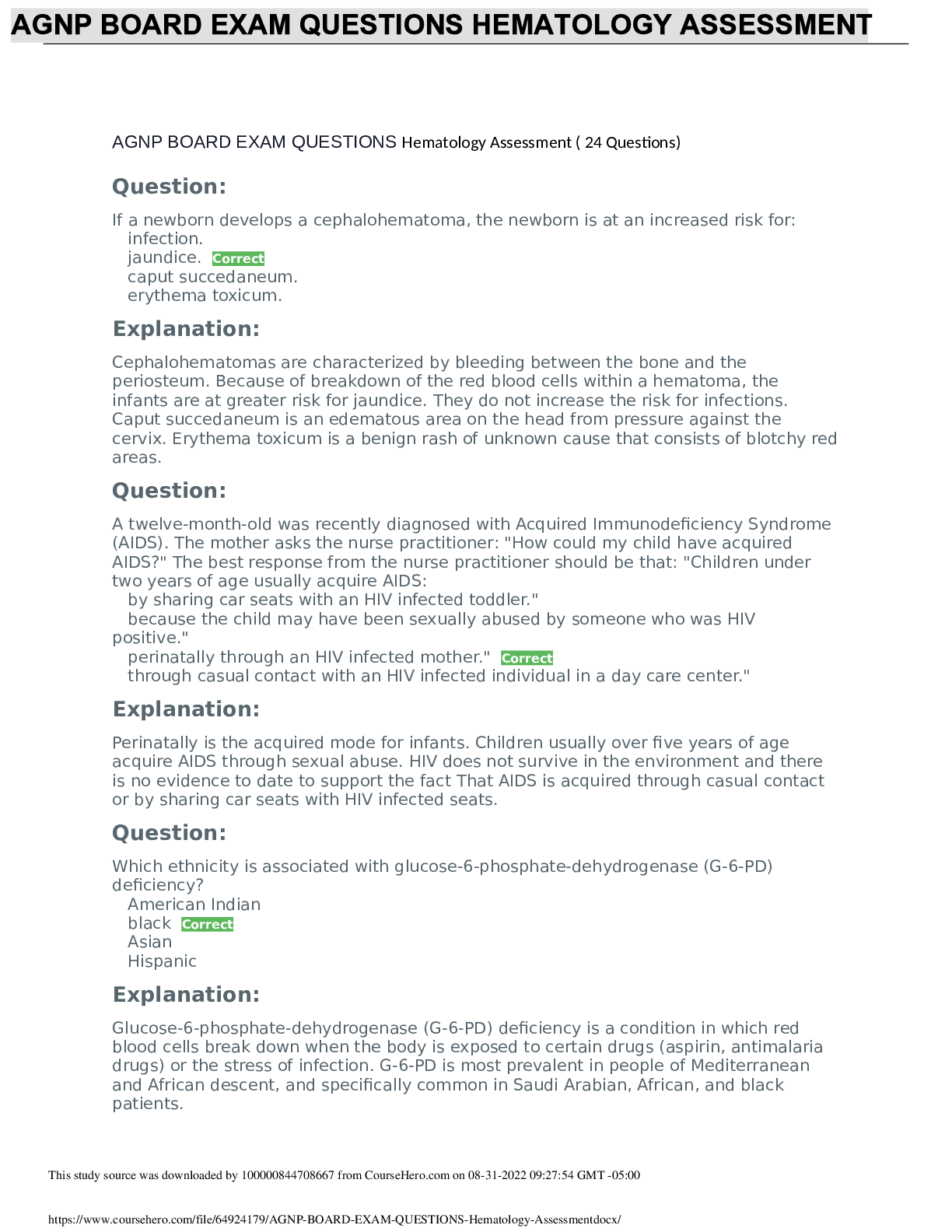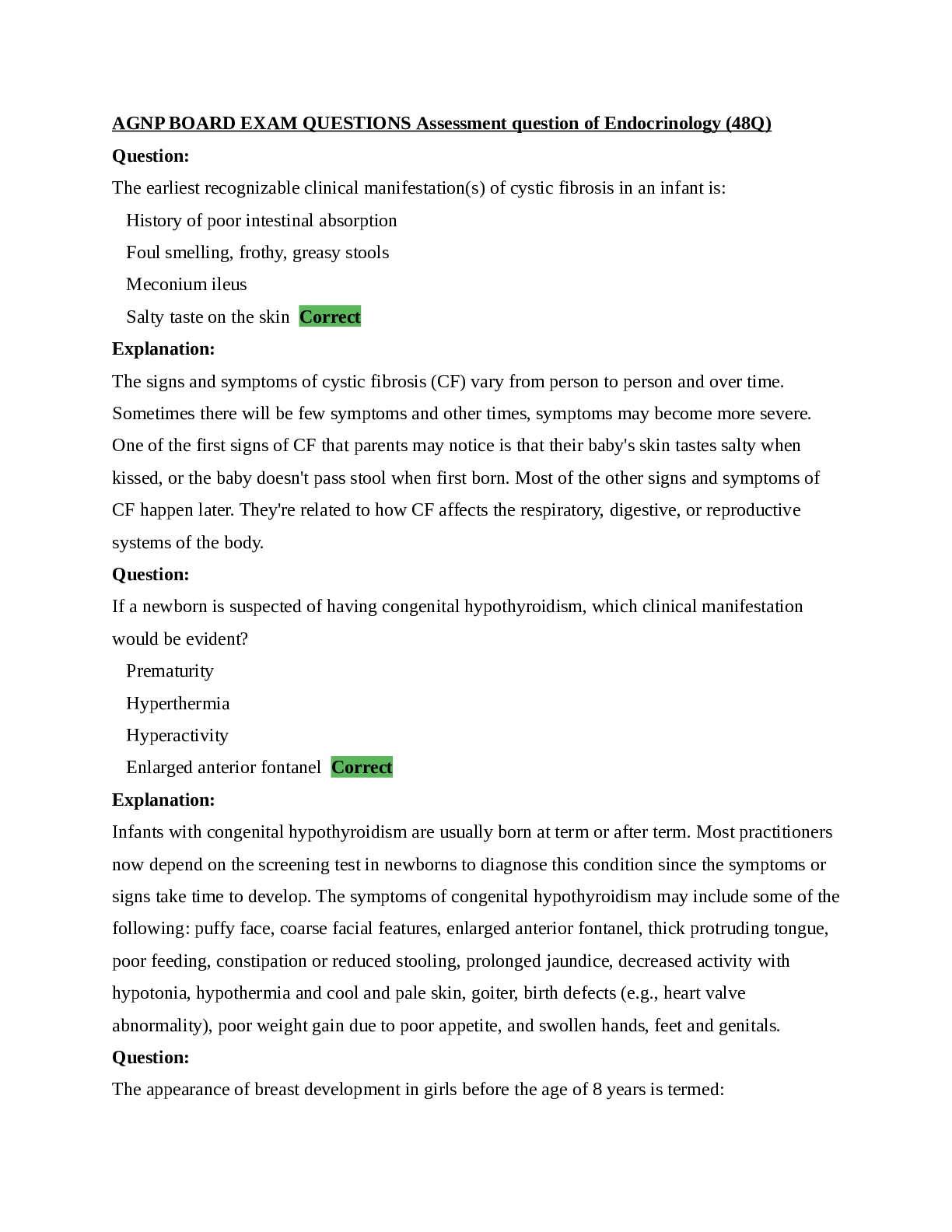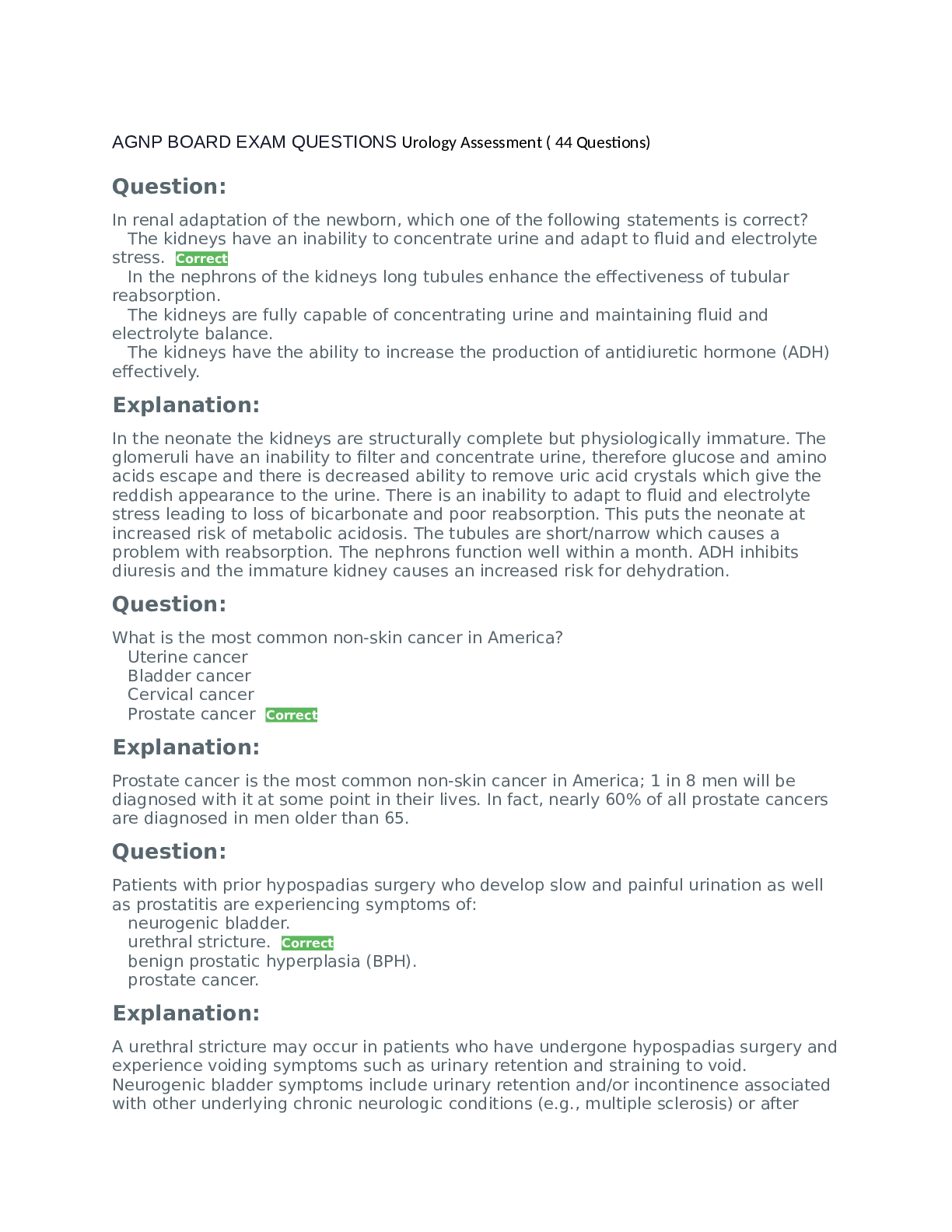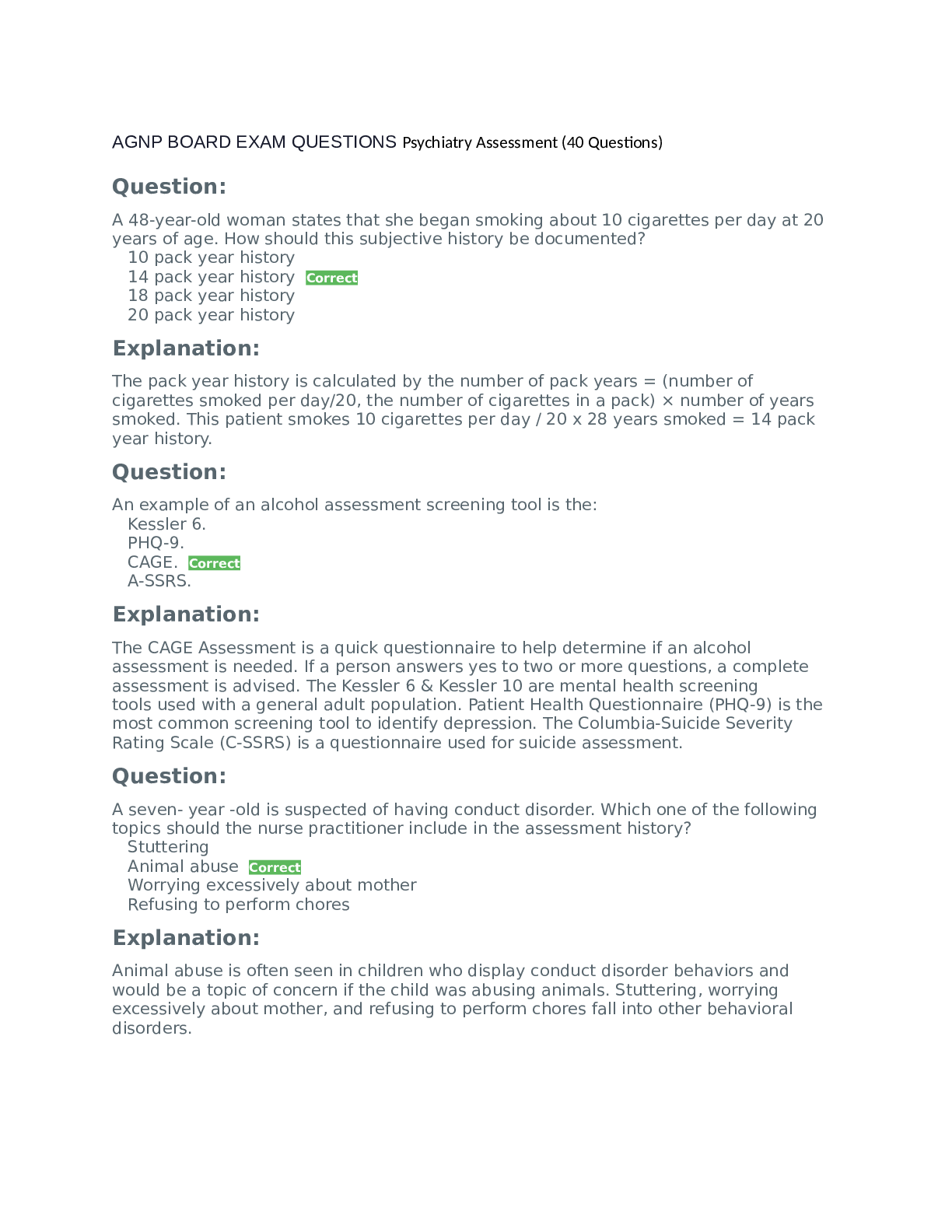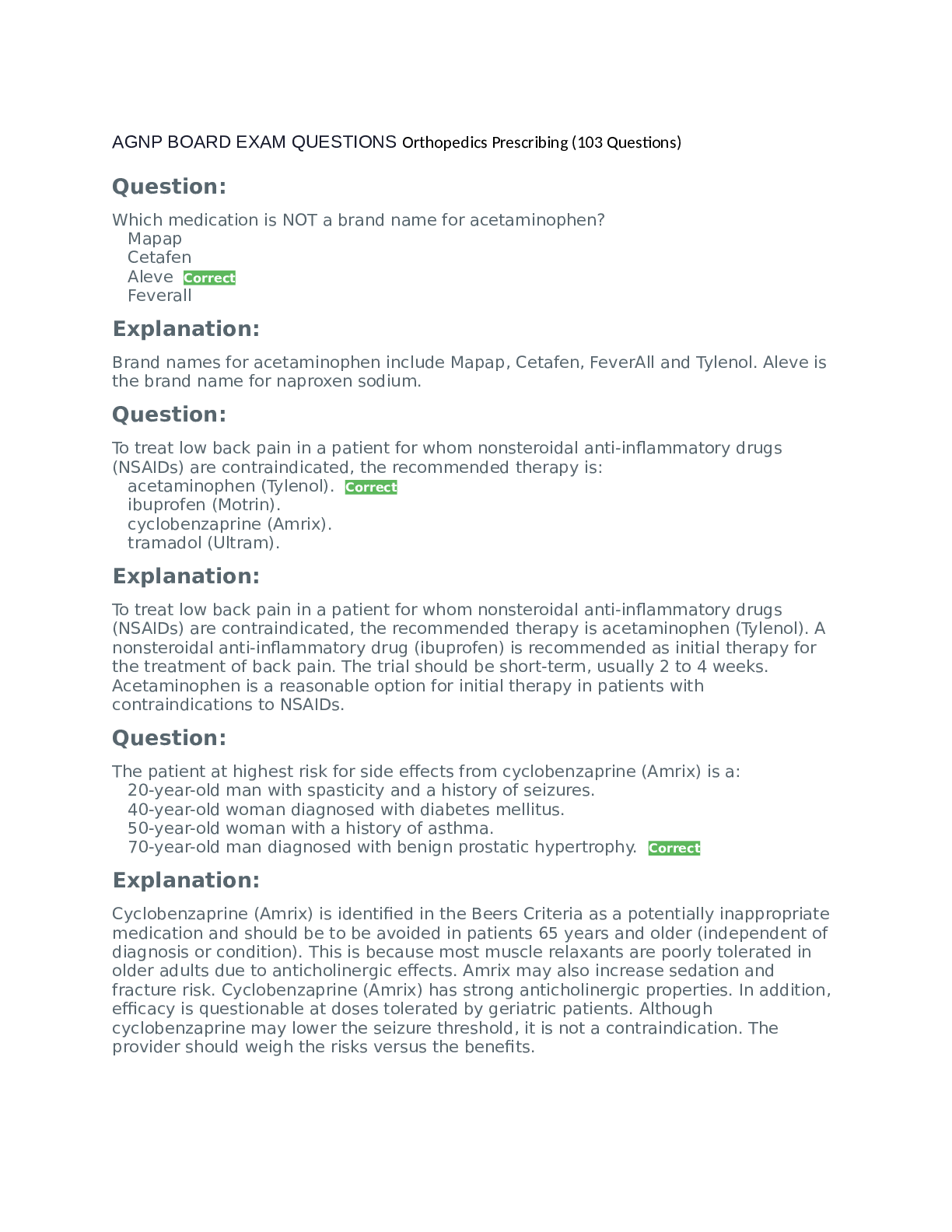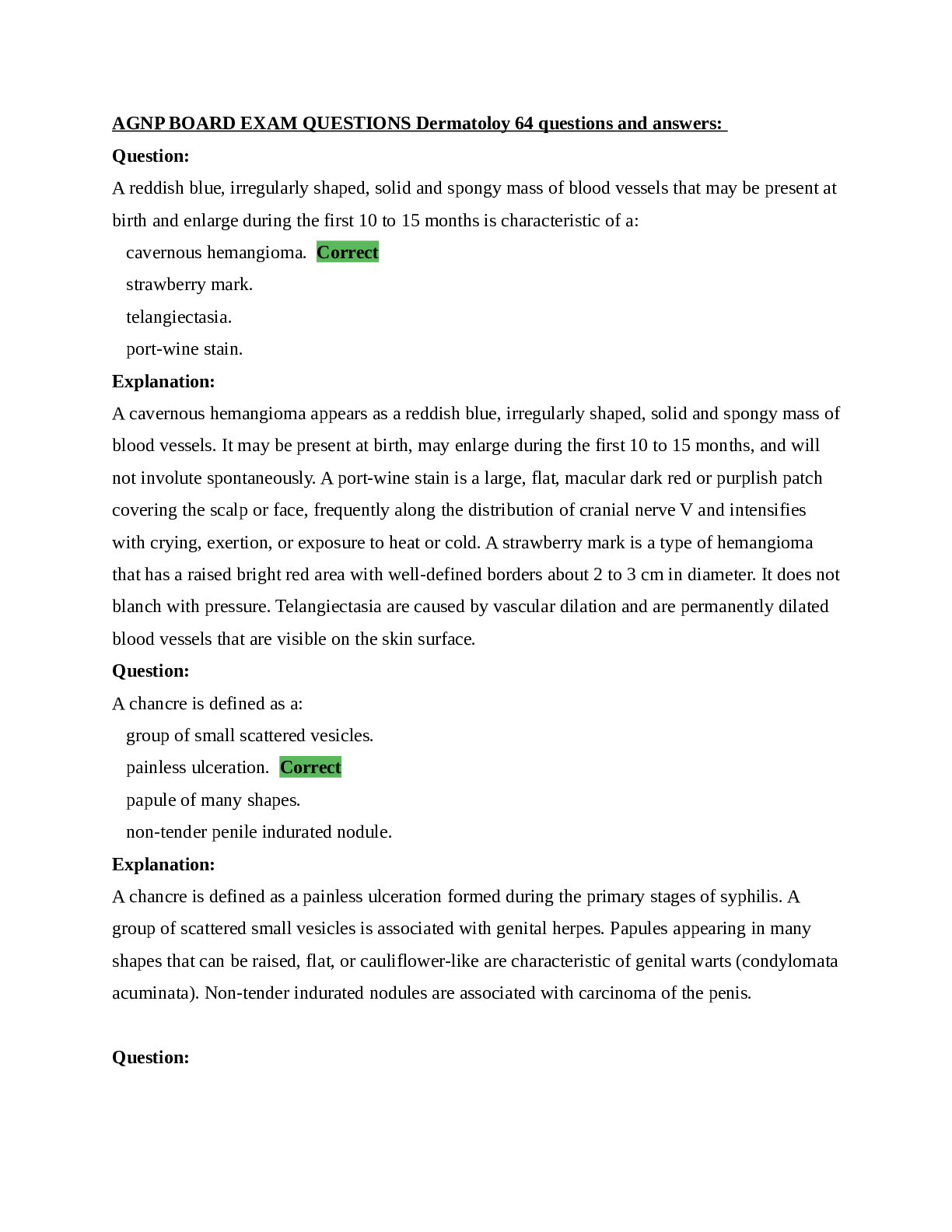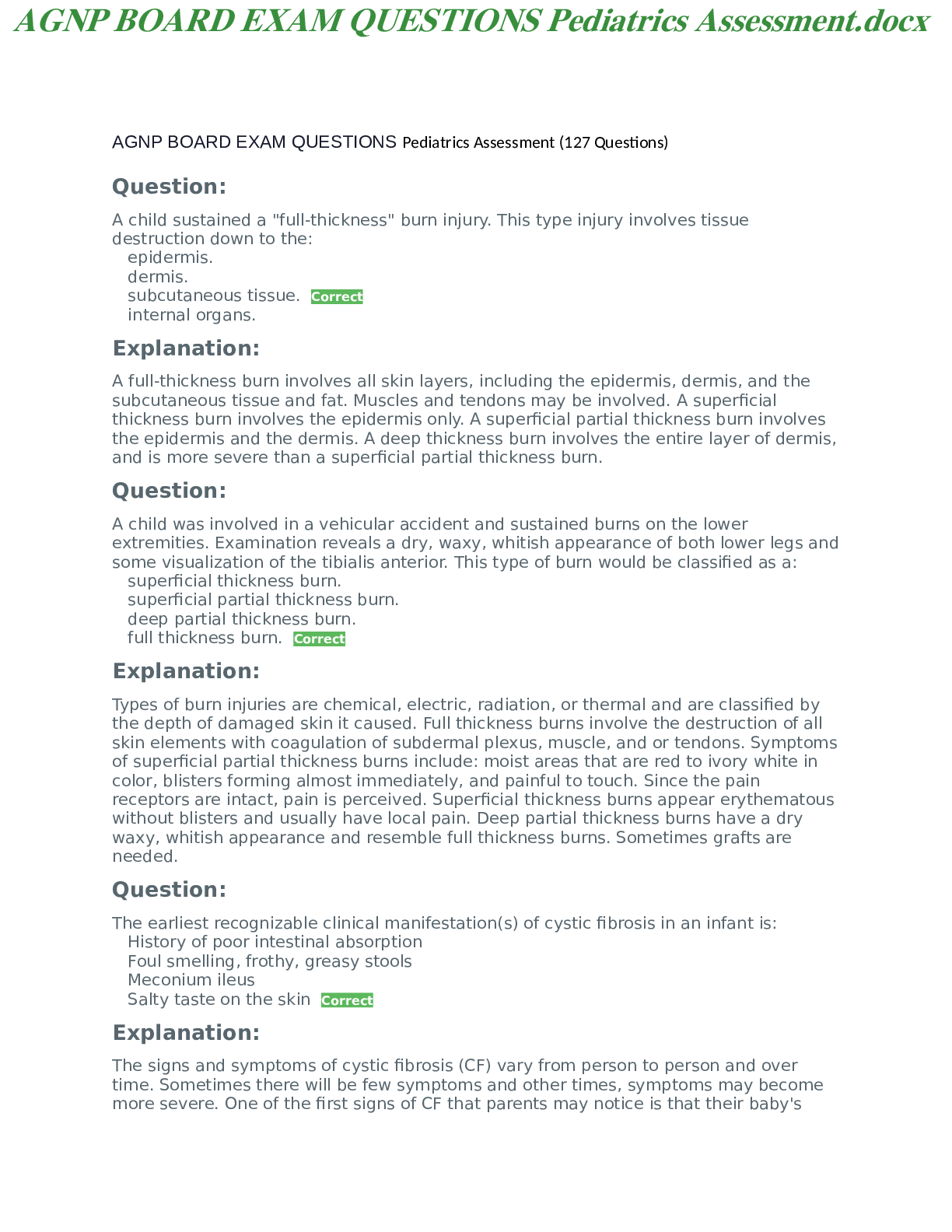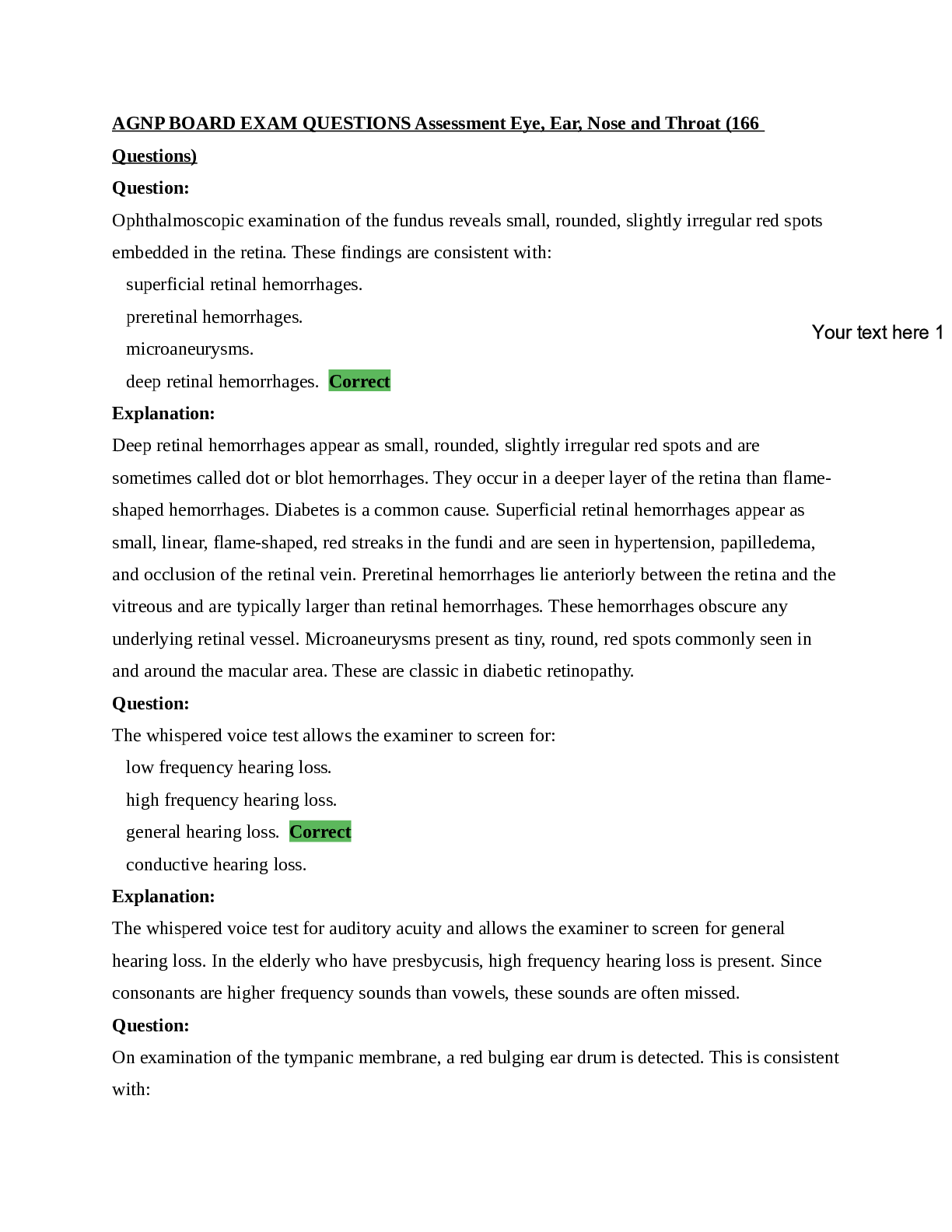*NURSING > QUESTIONS & ANSWERS > South University, Savannah NSG 6320 AGNP BOARD EXAM QUESTIONS Respiratory Assessment Already Passed (All)
South University, Savannah NSG 6320 AGNP BOARD EXAM QUESTIONS Respiratory Assessment Already Passed
Document Content and Description Below
AGNP BOARD EXAM QUESTIONS Respiratory Assessment (51 Questions) Question: Which technique best determines whether the tissues in the chest are air-filled, fluidfilled, or solid? Auscultation Palpa... tion Inspection Percussion Correct Explanation: Percussion of the chest produces audible sounds and palpable vibrations, thus, assisting in determining if the underlying tissues are filled with air or fluid or if they are solid. However, percussion will not help detect deep seated lesions. Auscultation assesses the flow of air through the tracheobronchial tree. Palpation focuses on tenderness and abnormalities in the overlying skin , respiratory expansion, and fremitus. Inspection notes the shape of the chest and they way it moves with inspiration and expiration. Question: The midaxillary line: extends from the anterior axillary fold where the pectoralis major muscle inserts. continues from the posterior axillary fold where the latissimus dorsi muscle inserts. runs down from the apex of the axilla and lies between and parallel to the anterior and posterior lines. Correct extends through the inferior angle of the scapula when the arms are at the sides of the body. Explanation: The anterior axillary line extends from the anterior axillary fold where the pectoralis major muscle inserts. The posterior axillary line continues from the posterior axillary fold where the latissimus dorsi muscle inserts. The midaxillary line runs from the apex of the axilla and lies between and parallel to the other two. The scapular line extends through the inferior angle of the scapula when the arms are at the sides of the body. Question: When percussing the lower posterior chest, begin by: standing on the side rather than directly behind the patient. Correct having the patient lie supine on the examining table. carefully palpating any area the patient has reported pain. using the ball or the ulnar surface of the hand. Explanation: When percussing the lower posterior chest, stand on the side rather than directly behind the patient. This position allows the ability to place the pleximeter finger more firmly on the chest and the plexor is more effective in making a better percussion note. If the patient is lying supine, the posterior chest will not be able to be percussed. Palpating painful areas is not percussion, so is not correct. Using the bony part of the palm at the base of the fingers or the ulnar surface is a technique used to detect tactile fremitus. Question: A 65-year-old obese man with a past medical history of hypertension complains of increased fatigue during the day. The practitioner orders a polysomnogram to test for: congestive heart failure (CHF). gastroesophageal reflux disease (GERD). obstructive sleep apnea (OSA). Correct chronic obstructive pulmonary disease (COPD). Explanation: A polysomnography is a standard diagnostic test for the diagnosis of obstructive sleep apnea (OSH) through sleep evaluation. OSH is also referred to as obstructive sleep apnea-hypopnea. This disorder involves cessation or a significant decrease in airflow in the presence of breathing effort and is characterized by recurrent episodes of upper airway collapse during sleep. It is also associated with excessive daytime sleepiness. Question: Pain from pleurisy may be referred to the: right shoulder. retrosternal area. epigastric area. Correct back. Explanation: Referred pain is defined as pain that is felt in more distal sites than the initial pain site. Pain from pleurisy or inferior wall myocardial infarction may be referred to the epigastric area. Referred pain from the biliary tree may be perceived in the right shoulder or the right posterior chest. Referred pain of duodenal or pancreatic origin may be referred to the back. Heartburn may be associated with retrosternal burning pain. Question: An acute viral illness that presents with a burning retrosternal discomfort and a dry cough is suggestive of: tracheobronchitis. Correct chronic bronchitis. bronchiectasis. laryngitis. Explanation: An acute viral illness that presents with a burning retrosternal discomfort and a dry cough is tracheobronchitis. An acute, mild illness associated with viral nasopharyngitis and hoarseness is laryngitis. The initial cough is dry and nonproductive but may become productive over time. A chronic bronchitis cough is characteristically productive with mucoid to purulent sputum and may be blood tinged. Bronchiectasis produces a chronic cough with sputum that is copious and foul-smelling. It may be blood tinged or bloody. Question: When examining a patient for chest expansion, begin by: hyperextending the examiner's middle finger of the left hand (pleximeter finger) and pressing its distal interphalangeal joint firmly on the surface to be examined. placing the thumbs of the examiner at about the level of the tenth ribs with the fingers loosely grasping and parallel to the lateral rib cage. Correct positioning the examiner's right forearm close to the chest surface with the hand cocked upward. standing on the side rather than directly behind the patient. Explanation: When examining a patient for chest expansion, begin by placing the thumbs of the examiner at about the level of the tenth ribs with the fingers loosely grasping and parallel to the lateral rib cage and slide them medially just enough to raise a loose fold of skin on each side of between the thumb and the spine. Watch chest expansion as the patient inhales and exhales checking for symmetry and range. The other choices are steps used when percussing the chest. Question: A patient who presents with a long history of cigarette smoking exhibits a dry to productive cough with dyspnea and weight loss. These symptoms could be consistent with: a pulmonary embolus. asthma. a neoplasm of the lung. Correct chronic obstructive pulmonary disease. Explanation: The characteristic cough associated with smoking is usually productive. A long history of smoking, dry cough, dyspnea, and weight loss could be suggestive of cancer of the lung. A pulmonary embolus is usually accompanied by a dry to productive bloody cough, dyspnea, anxiety, chest pain, and fever. Cigarette smoking is not directly linked to pulmonary embolus. Episodic wheezing and dyspnea are characteristic of asthma. Symptoms associated with chronic obstructive lung disease include slowly progressive dyspnea accompanied by a scant mucoid sputum. The dyspnea is aggravated by exertion. Question: The hilar region of the lungs describes: the area around the heart. Correct the base of the lungs. the posterior chest. the upper, anterior area of the chest. Explanation: The area around the heart near the center of the lungs describes the hilar region. The hila are structures consisting of the major bronchi and pulmonary veins and arteries. Hilar lymph nodes are not normally visible on chest X-ray. Question: A condition associated with a chronic cough that produces copious amounts of purulent sputum is most likely: tracheobronchitis. chronic bronchitis. bronchiectasis. Correct laryngitis. Explanation: An acute viral illness that presents with a burning retrosternal discomfort and a dry cough is tracheobronchitis. An acute, mild illness often associated with viral nasopharyngitis and hoarseness is laryngitis. The initial cough is dry and nonproductive but may become productive over time. A chronic bronchitis cough is characteristically productive with mucoid to purulent sputum and may be blood tinged. Bronchiectasis produces a chronic cough with sputum that is copious and foul-smelling. It may be blood tinged. Question: To document chest findings located below the scapulae, which one of the following terms would be used? Infraclavicular Supraclavicular Interscapular Infrascapular Correct Explanation: The general anatomical terms used to locate chest findings should include the following: infrascapular refers to below the scapulae; supraclavicular denotes above the clavicles; infraclavicular refers to that area below the clavicles; and interscapular is between the scapulae. Question: A 37-year-old female has audible stridor. This type of stridor is consistent with: bronchiectasis. pulmonary fibrosis. cystic fibrosis. a foreign object lodged in the upper trachea. Correct Explanation: Audible stridor is a high-pitched wheeze. This is an ominous sign of upper airway obstruction in the larynx or trachea. Clubbing of the nails occurs in bronchiectasis, congenital heart disease, pulmonary fibrosis, cystic fibrosis, lung abscess, and malignancy. These conditions are more characteristic of lower airway diseases. Question: When auscultating breath sounds in a patient who has left sided heart failure, the breath sounds are: vesicular with late inspiratory crackles in the dependent portions of the lungs and resonant on percussion. Correct bronchial with late inspiratory crackles over the involved area and dull on percussion. vesicular without adventitious sounds and resonant on percussion. decreased with some audible wheezes and diffusely hyperresonant on percussion. Explanation: A patient with left sided heart failure experiences increased pressure in the pulmonary veins causing congestion and interstitial edema. The breath sounds are vesicular with late inspiratory crackles in the dependent portions of the lungs and are resonant on percussion. Consolidation in the lungs produces bronchial breath sounds with late inspiratory crackles over the involved area and is dull on percussion. A normal lung has vesicular breath sounds without adventitious sounds and is resonant on percussion. Chronic obstructive lung disease produces decreased breath sounds with some audible wheezes and is hyperresonant on percussion. Question: Atypical respiratory symptoms associated with gastroesophageal disease (GERD) may include all of the following except: coughing. wheezing. aspiration pneumonia. rhinitis. Correct Explanation: Atypical respiratory symptoms associated with gastroesophageal disease may include coughing, wheezing, asthma, an [Show More]
Last updated: 1 year ago
Preview 1 out of 16 pages
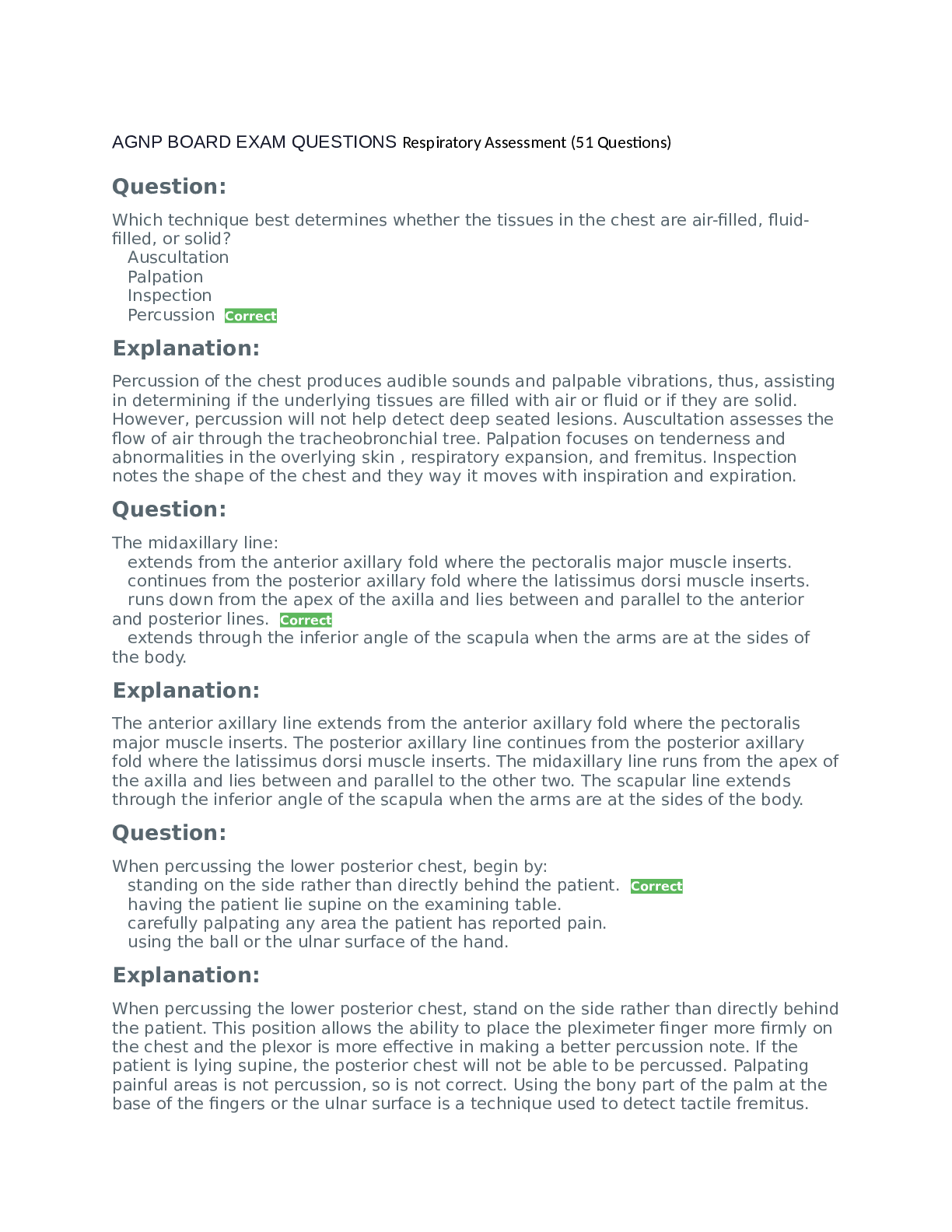
Reviews( 0 )
Document information
Connected school, study & course
About the document
Uploaded On
Apr 22, 2022
Number of pages
16
Written in
Additional information
This document has been written for:
Uploaded
Apr 22, 2022
Downloads
0
Views
62

.png)
.png)
.png)
.png)
.png)
.png)


